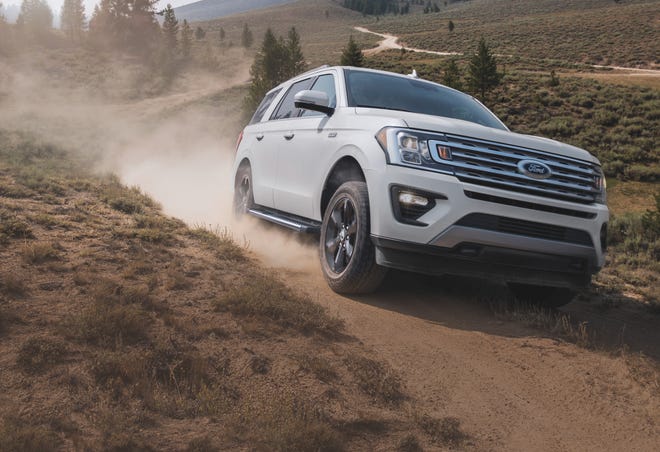Ford Motor Co., hit with a lawsuit last month by owners of the 2021 Expedition and 2021 Lincoln Navigator angry about an unfixable fire recall, announced Friday that the company has figured out the problem and the solution.
At the same time, the company expanded its recall from 39,013 to just over 66,000 SUVs based on its analysis of the problem.
Ford has not asked customers to stop driving the vehicles, telling regulators it is not aware of any accidents caused by the faulty parts.
However, drivers of these premium vehicles with a base price that exceeds $50,000 are still being advised to park outdoors and away from structures until the repair is made. Vehicles may pose a risk of under-hood fire, including while the vehicle is parked and off.

Ford has received 21 reports of under-hood fires — including five since the original recall filing in May — with 18 incidents impacting vehicles owned by rental companies. Ford is aware of one reported burn injury, according to documents filed with the National Highway Transportation Safety Administration (NHTSA).
Two-thirds, or an estimated 44,000 owners, won’t be able to get the repair until September because of parts delivery challenges, Ford said. .
The Dearborn automaker said in a news release that the company traced the cause of the vehicle fire problems to a change in manufacturing location by a supplier during the COVID-19 pandemic.
‘High-current short’
“Printed circuit boards produced at this facility are uniquely susceptible to a high-current short and were supplied to Ford and installed in Expedition and Navigator SUVs produced” between July 27, 2020, and Aug. 31, 2021, the release said.

Ford dealers have sent a repair protocol to its dealers, who are “working quickly” to make parts available as soon as possible, Ford said in the release.
First, dealers will inspect the battery junction box for melting damage, and if it’s observed, will replace the entire component. Then the repair team will remove the engine fan ground wire from the battery junction box in affected vehicles with an 800-watt cooling fan system, which represents about one-third of the recalled vehicle population, Ford said.
“This repair can be done immediately,” Ford said.
For the remaining affected vehicles with a 700-watt cooling fan system, the repair is the same, except for the installation of an auxiliary box with a wire jumper, Ford said. Parts for this repair are scheduled for delivery in early September.
Ford was to notify affected customers by Friday, with follow-up communication to customers of vehicles with 700-watt systems when parts are available.
Supplier problems
In June, John McElroy, longtime industry analyst and host of the “Autoline After Hours” podcast and webcast, questioned whether a significant number of recall and warranty issues might be blamed on a breakdown in communication between Ford and its suppliers.
Analyst Dan Levy, of Credit Suisse global investment bank, visited Ford in Dearborn in June, following the recall announcements. He highlighted concerns about recalls in his investor note June 17.
“Quality challenges stem from issues with suppliers and design robustness,” Levy wrote. Management “fully acknowledges quality is an issue that must be addressed, that Ford is underperforming vs. peers, and that warranty spend is not competitive vs. peers.”
More:Ford’s ‘self-inflicted’ recalls, warranty costs put automaker at competitive disadvantage
More:Ford specialist has plan to overhaul culture, stop warranty claim finger-pointing
More:Ford workers break their silence on faulty transmissions: ‘Everybody knew’
Initially, the company recalled 32,711 Expeditions and 6,302 Lincoln Navigators built between Dec. 1, 2020, and April 30, 2021. The federal paperwork had not yet been posted on the public website that provides specific details about how many of each vehicle is affected.
‘Shifting risk’ to consumers
The law firm filing the suit on behalf of Expedition and Lincoln owners, Seattle-based Hagens Berman Sobol and Shapiro, is seeking to have the case certified as a class action and said it’s investigating model years beyond 2021.
Steve Berman, managing partner and co-founder of the law firm, told the Free Press on Friday: “While it is positive news that Ford believes it has found its manufacturing defect that is behind at least 21 dangerous spontaneous fires in its luxury vehicles, at the same time, Ford has now admitted that this defect affects nearly 60,000 vehicles that are still covered under warranty. Ford claims to have designed a fix, yet admits it only has parts for a small subset of the affected vehicles and the timeline Ford presents is at best several months in the future for most vehicles to be repaired. In the meantime, affected owners are stuck with expensive vehicles that they can only use if they assume a risk of fire, and can’t park at their homes or work or near anything flammable.”
‘Nightmare’
For Ford and Lincoln owners, especially those with young children in car seats, the situation remains a “nightmare,” Berman said. “To add insult to potential injury, Ford has also failed to provide any substitute vehicles or compensation for those who choose not to assume the risk of fire to continue using their vehicle.”
More:Ford’s plan to cut $3B in waste to fund electric, tech
The lawsuit continues, he said, because Ford is shifting the risk of fire onto consumers, even though these cars are supposed to be warrantied for the very type of manufacturing defect that Ford admits is in these cars.
“We will continue to fight for our clients’ rights until Ford actually provides and installs a repair and reimburses owners of these vehicles for their damages from having these risks and troubles foisted upon them,” Berman said, “notwithstanding the warranties for manufacturing defects that Ford provides.”
.
Contact Phoebe Wall Howard at313-618-1034orphoward@freepress.com.Follow her on Twitter@phoebesaid. Read more on Ford and sign up for our autos newsletter.